Objective: To evaluate the top 30 most-cited articles in the literature on os odontoideum.
Methods: A search using the Web of Science database and the search phrase "os odontoideum" was conducted. The 30 most-cited articles on osodontoideum were analyzed. The study was performed in May 2020. We searched for articles published between 1920 and 2020. Articles were sorted and ranked according to the total number of citations. We evaluated the following information of each article, including first author, journal, title, number of citations, average citation per year, and author affiliation.
Results: A total of 357 studies matched our search criteria, of which the top 30 most-cited ranged between 232 and 60 citations. The article by Dickman et al. published in Neurosurgery, was the most-cited article with a total citation of 232, followed by Dickman et al. with 221 and Smoker et al. with 179. Menezes was the most cited first authors, with 4 articles, followed by Dickman with 3 articles. Child's Nervous System, Journal of Neurosurgery, and Spine were three most frequent destination journals. Most of the articles originated from the United States (n=24) and University of Iowa Hospitals and Clinics published 6 articles and was the highest in the number of most-cited articles. Most of the articles focused on the clinical management of osodontoideum (83.3%).
Conclusion: The current study confers a better understanding of current treatment strategies and the advances in the management of osodontoideum. It helps guide the clinical management and academic achievements.
Keywords
Os odontoideum, Top-cited articles, Bibliometric study
Abbreviations
OO: Os odontoideum; CVJ: Craniovertebral Junction; MRI: Magnetic Resonance Imaging; 3D CTA: 3-Dimensional Computed Tomographic Angiography
Os Odontoideum (OO), known as a rare anomaly of the cervical spine and can be confused with fracture, involves the second cervical vertebrae, which is characterized by the separation of a portion of the odontoid process (also known as dens) from the body of the axis.1,2 It was first described by Giacomini in 1886, and whether the etiology of OO is congenital or traumatic has remained controversial. 3-5 Notably, OO leads to the instability of atlanto-axial joint, which will increase the risk of spinal cord and vertebral artery injury. 6,7 Moreover, the various clinical manifestations can occur, such as neck pain, limb numbness and weakness, syncope, and even paralysis.8,9 The management for OO depends on the symptoms of the patients and the clinical experiences of the surgeons, including conservative treatment and surgical treatment.10-12 The most common surgical technique is atlanto-axial reduction, fixation, and fusion.8,13,14 However, there still exists controversy regarding the management of OO.6 Therefore, it is pivotal for the surgeons to get a good knowledge of OO management and to better the treatment from the high-impact journal articles.
The bibliometric study gives us a clear list of the high-impact articles according to the number citation, which will confer a better understanding of the scientific information pertaining to OO, such as top authors, top journals, and top institutions. Our objective was to identify and analyze the 30 top-cited articles on OO.
On October 5, 2020, the Web of Science core database was searched with the search phrase “osodontoideum”, the 30 top-cited articles on osodontoideum were sought. Articles published between 1980 and 2020 were searched and the total number was 361. Four articles were excluded due to the unavailability of the publication year, and a total of 357 articles were ranked according to the total number of citations in this study. The articles with the same number of citation were ranked the same (and counted separately) and the total number of the articles included in this study were 30. First, we evaluated the following information of each article: first author, year of publication, journal, title, number of citation, average citation per year, and author affiliation. Next, we recorded lists for top authors (with at least 2 publications), top publication journals, and decades of publication. We also summarized the country of origin of the 30 top-cited articles, as well as the institutions with the most publications. Finally, we recorded the research topic of article as clinical management, radiology or imaging study, or biomechanical study.
Top 30 Most-Cited Articles
A total of 357 studies matched our search criteria, of which the top 30 most cited ranged between 60 and 232 citations, for a total of 3124 citations, with an average of 104.13 Citations per article (Table 1). Thirteen articles were cited more than 100 times. “Posterior C1-C2 transarticular screw fixation for atlanto-axial arthrodesis”, by Dickman et al., was the most-cited article with a total citation of 232.
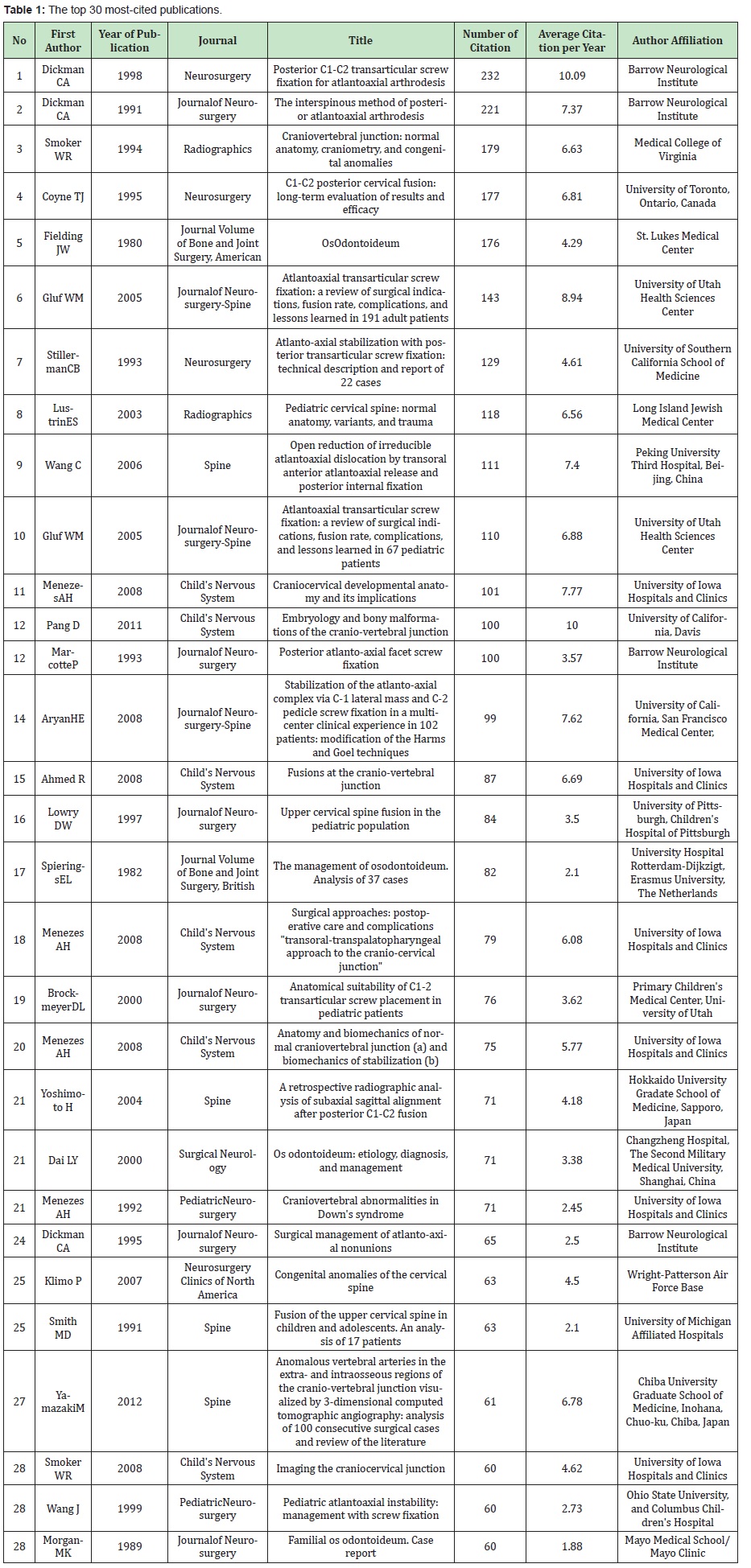
Top authors
In summary, 23 first authors contributed to the top 30 top-cited articles. Only 4 first authors published at least 2 of the top 30 most-cited articles (Table 2). Menezes published 4 articles. Dickman published 3 articles. (Figure 1)
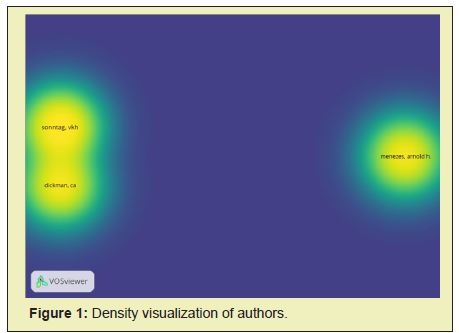
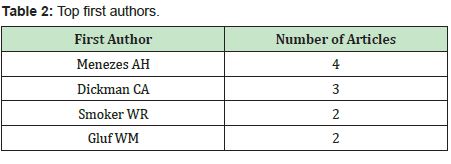
Top Publication Journals
In summary, 11 journals published the top 30 most-cited articles, of which 7 journals published at least 2 articles (Table 3). Child's Nervous System published 6 articles, which was the same as Journal of Neurosurgery. Spine had the second most articles (n=4). Journal of Neurosurgery-Spine and Neurosurgery had published 3 articles, respectively.
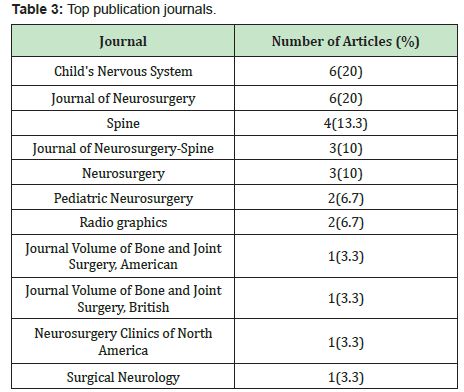
Countries of Origin
The 30 most-cited articles originated from a total of 5 countries (Table 4). The United States produced the most articles (n=24). China and Japan published 2 articles each, followed by Canada and The Netherlands (n=1 each).
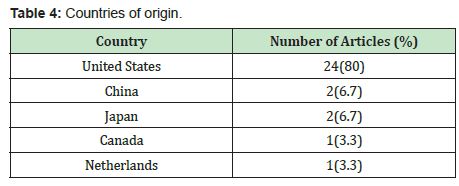
Top Institutions of Publication
A total of 21 institutions were affiliated with the 30 most-cited articles. Three institutions published at least publications (Table 5). University of Iowa Hospitals and Clinics published 6 articles and was the highest in the number of most-cited articles. Barrow Neurological Institute published 4 articles, followed by University of Utah Health Sciences Center (n=2).
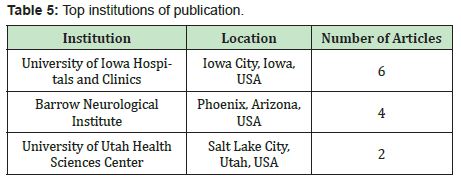
Decades of Publication
All top 30 most-cited articles were published between the 1980s and the 2010s (Table 6). The oldest of these articles, “Os- Odontoideum” by Fielding et al., was published in 1980. The most recent of these articles, was published by Yamazaki et al. in 2012. The other article published in 2010s was “Embryology and bony malformations of the craniovertebral junction” by Pang et al. in 2011 with total of 100 citations. The largest proportion (46.7%) of the articles was published in the 2000s.
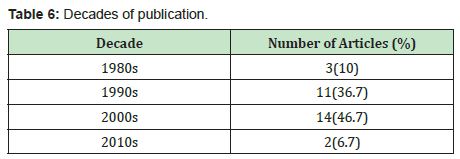
Research Topics
Research topics of the 30 top-cited articles were classified into clinical management, radiology or imaging study, and biomechanical study (Table 7). Twenty-five (83.3%) of the articles mainly discussed clinical management, 4(13.3%) focused on imaging study of os odontoideum, and 1(3.3%) was biomechanical study.

The current bibliometric study mainly focuses on the thirty top-cited articles in Os Odontoideum. The citation count is a standardized tool for the researchers to evaluate the impact of the literature. We assessed the top authors, top publication journals, the country and institutions of origin, and the research topic of the 30 top-cited articles, which can show us the most impactful articles and authors and help us improve the management of Os odontoideum.
The first author of the two top-cited articles is Dickman CA from Barrow Neurological Institute, and the two articles were published in Neurosurgery15 and Journal of Neurosurgery16 respectively. The two articles mainly focused on the clinical management of OO via posterior atlantoaxial arthrodesis. The most-cited article published in 1998 assessed the outcomes associated with C1-C2 transarticular screw fixation15; this study included nine patients with OO, .these ninepatients nine patients were treated with posterior C1-C2 transarticular screws and wired posterior C1-C2 antilogous bone struts. No patients presented with neurological complications, strokes, or transient ischemic attacks. Long-term follow-up (mean, 22 months) of 114 patients suggested a 98% fusion rate. Two nonunion (2%) required occipitocervical fixation. For a comparison, the union rate of C1-C2 fixations with wires and auto graft (n=74) was 86%. This study indicated that C1-C2 transarticular screw fixation was associated with a markedly higher fusion rate than that achieved using wired grafts alone. Additionally, the risk of screw malpositioning and severe vascular or neural injury is small and can be minimized by using intraoperative fluoroscopy guidance.
The second most cited article also focused on the interspinous method of posterioratlantoaxial arthrodesis.16; this study included four cases of OO and the atlantoaxial arthrodesis utilized sub laminar wire at C1 and an iliac-crest strut-graft between the posterior arches of C1 and C2. The arthrodesis was secured by a wire around the base of the spinous process of the axis. This study concluded that interspinous method of posterior atlantoaxial arthrodesis resulted in a 97% union rate with minimal morbidity and mortality rates.
“Craniovertebral junction: normal anatomy, craniometry, and congenital anomalies”, a study by Smoker, was the third most-cited article.17 This study is an imaging-based one using magnetic resonance imaging (MRI) and aims to evaluate craniovertebral junction (CVJ)abnormalities such as OO, radio logically, via craniometricalmeasurements, including the Chamberlain line, Wackenheimclivus baseline, Welcher basal angle, and atlantooccipital joint axis angle. This study suggested that MRIis a suited method for investigating the CVJ abnormalities because of its direct sagittal imaging capabilities.
The oldest most-cited article entitled “Os Odontoideum” in the top 30 is a review of Fieldinget al., which was published in 1980 and rankedranked fifth in the list with 176 citations.18 This article reviewed the cases of 35 patients with Osodontoideum . This study provided evidence that the etiology of OO is trauma. Most of the patients were treated with spine fusion surgery and the surgical management alleviated cervical pain and instability.
The most recent of the 30 top-cited articles is a 100 consecutive surgical cases and review of the literature by Yamazaki based on 3-dimensional computed tomography angiography (3D CTA).19 This study described the utility of 3D CTA in the evaluation of vertebral artery anomalies in the patients with CVJ disorders preoperatively. This study indicated that an increased rate of vertebral artery anomalies in patients with atlantoaxial subluxation, OO, and occipitalization of C1. With the help of 3D CTA, the vertebral artery anomalies can be identified accurately, and the risk of their intraoperative injury can be reduced consequently.
Most of the articles in the 30 top-cited articles were published in Child's Nervous System, Journal of Neurosurgery, and Spine, suggesting that OO is an important cervical anomaly in children and much attention should be paid to improve their quality of life.
In the 30 top-cited articles, most studies focused on the clinical management of OO. And these studies suggested that fusion is a well-suited surgical treatment, both in children and adultpatients. Only four radiological studies and one biomechanical study20 were included in the list, and biomechanical study might provide us with more insights into the etiology and management of OO.
The current study has several limitations. First, self-citation is a confounding factor which will influence the citation analysis, which was not excluded in this study. Second, non-English language literature was excluded, which might have been highly cited in other language literature database. Third, older literature might have high citations, but it might be considered less valuable compared with the newly updated literature.
The present bibliometric study analyzed the 30 top-cited articles focusing on Os Odontoideum, an anomaly of the craniovertebral junction with great surgically challenge. Most of the articles focus on surgical management. The majority of the articles originated from the United States and institutions in the United States, including University of Iowa Hospitals and Clinics and Barrow Neurological Institute. The current study confers a better understanding of current treatment strategies and helps guide the clinical management and academic achievements.
None.
None.
The authors declare that they have no known competing financial interests or personal relationships that could have appeared to influence the work reported in this paper.
The authors declare the following financial interests/personal relationships which may be considered as potential competing interests.
- 1. Hedequist DJ, Mo AZ. Os Odontoideum in Children. J Am Acad Orthop Surg. 2020;28(3):e100–e107.
- 2. Aydin F, Bayraktutan U, Sade R, et al. The Rare Anomaly That Can Be Confused With Fracture: Os Odontoideum. J Craniofac Surg. 2020;31(1):e67.
- 3. Bayram S, Akgul T, Ozmen E, et al. A Rare Spinal Injury: Gunshot Wound to The Odontoid Process. Spine (Phila Pa 1976). 2019;44(22):E1342– E1347.
- 4. Sergeenko OM, Dyachkov KA, Ryabykh SO, et al. Atlantoaxial dislocation due to os odontoideum in patients with Down’s syndrome: literature review and case reports. Child’s nervous system. 2020;36(1):19–26.
- 5. Klimo P Jr, Rao G, Brockmeyer D. Congenital anomalies of the cervical spine. Neurosurg Clin N Am. 2007;18(3):463–478.
- 6. Lee S, Kim DH, Choi YH. What is the best treatment option for cervical spinal cord injury by os odontoideum in a patient with athetoid dystonic cerebral palsy? J Spinal Cord Med. 2020:1–5.
- 7. Helenius IJ, Bauer JM, Verhofste B, et al. Os Odontoideum in Children: Treatment Outcomes and Neurological Risk Factors. J Bone Joint Surg Am. 2019;101(19):1750–1760.
- 8. Jumah F, Alkhdour S, Mansour S, et al. Os Odontoideum: A Comprehensive Clinical and Surgical Review. Cureus. 2017;9(8):e1551.
- 9. Buntting CS, Dower A, Seghol H, et al. Os odontoideum: a rare cause of syncope. BMJ Case Rep. 2019;12(11).
- 10. Gluf WM, Brockmeyer DL. Atlantoaxial transarticular screw fixation: a review of surgical indications, fusion rate, complications, and lessons learned in 67 pediatric patients. Journal of Neurosurgery-Spine. 2005;2(2):164–169.
- 11. Gluf WM, Schmidt MH, Apfelbaum RI. Atlantoaxial transarticular screw fixation: a review of surgical indications, fusion rate, complications, and lessons learned in 191 adult patients. Journal of Neurosurgery-Spine. 2005;2(2):155–163.
- 12. Wang C, Yan M, Zhou HT. Open reduction of irreducible atlantoaxial dislocation by transoral anterior atlantoaxial release and posterior internal fixation. Spine. 2006;31(11):E306–E313.
- 13. Rozzelle CJ, Aarabi B, Dhall SS, et al. Os odontoideum. Neurosurgery. 2013;72Suppl 2:159–169.
- 14. Wu X, Wood KB, Gao Y, et al. Surgical strategies for the treatment of os odontoideum with atlantoaxial dislocation. J Neurosurg Spine. 2018;28(2):131–139.
- 15. Dickman CA, Sonntag VK. Posterior C1-C2 transarticular screw fixation for atlantoaxial arthrodesis. Neurosurgery. 1998;43(2):275–280.
- 16. Dickman CA, Sonntag VK, Papadopoulos SM. The interspinous method of posterior atlantoaxial arthrodesis. Journal of neurosurgery. 1991;74(2):190–198.
- 17. Smoker WR. Craniovertebral junction: normal anatomy, craniometry, and congenital anomalies. Radiographics. 1994;14(2):255–277.
- 18. Fielding JW, Hensinger RN, Hawkins RJ. Os Odontoideum. J Bone Joint Surg Am. 1980;62(3):376–383.
- 19. Yamazaki M, Okawa A, Furuya T, et al. Anomalous Vertebral Arteries in the Extra- and Intraosseous Regions of the Craniovertebral Junction Visualized by 3-Dimensional Computed Tomographic Angiography Analysis of 100 Consecutive Surgical Cases and Review of the Literature. Spine. 2012;37(22):E1389–E1397.
- 20. Menezes AH, Traynelis VC. Anatomy and biomechanics of normal craniovertebral junction (a) and biomechanics of stabilization (b). Childs Nervous System. 2008;24(10):1091–1100.

